
Archive
515 posts

Digital technologies are fixed features of modern agriculture – but to what extent are they already being used in Switzerland? A survey conducted by Agroscope provides answers to this question. Digital technologies reduce the physical workload of farming and contribute to sustainable field management. They also enable optimised management decisions based on plant- or soil-related…

Digital Technologies in Swiss Livestock Production
Digital technologies represent an opportunity for the modern management of farms. For this, already available technologies must also be utilised in practice. An Agroscope survey illustrates the status quo of technology use.

Manure: Nutrient Excretion by Calves from Suckler Cows
Farms operate with a balanced nutrient cycle. Agroscope adjusted the reference values for suckling calves to the latest advances in animal production. The values for feed intake and nutrient excretion are now lower.

Large Predators Make Cost-Effective Alpine Summer Grazing of Sheep Difficult
Protecting sheep from large predators means more work and higher costs for alpine farmers. The economic consequences of the necessary adjustments were investigated in 2017 and 2018 on 13 alpine farms in the cantons of Uri and Valais.

Limiting Protein Supply in Cattle Feeding
Grassland-based milk and meat production promotes the site-specific feeding of ruminants. With the AP22+, the reduction of protein supply via concentrates is under discussion. Agroscope studied the effects of limited protein supply.

Excellent Performance with Larger Litters in Free-Farrowing Pens
Since 2007, only free-farrowing pens may be used in Switzerland. Since then, litter size has increased significantly. Despite this, piglet mortality during the lactation period has remained stable over the years.
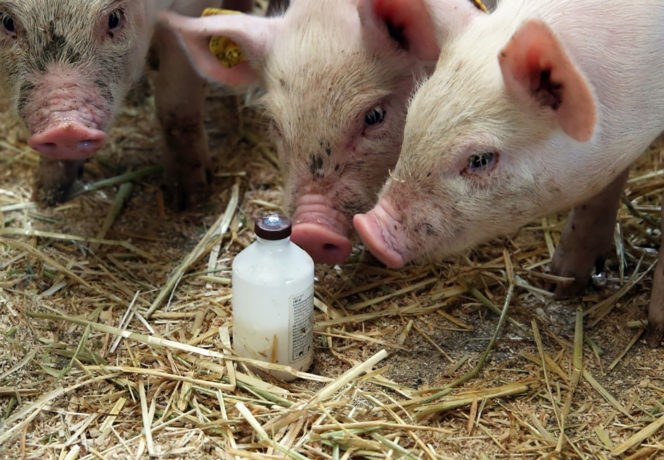
Fighting Antibiotic Resistance: a Plant to Reduce Diarrhoea in Piglets
Alternatives to antibiotics must be found to combat antibiotic resistance in animal production. The forage plant sainfoin reduces postweaning diarrhoea in piglets, thus reducing the need for antibiotic treatment.

Estimating Herbage Mass to Make Optimal Use of Pastures
Grazing dairy cows is a characteristic feature of Swiss agriculture. In order to use pasture efficiently, the estimation of herbage mass is recommended. Agroscope compared two methods and developed estimation formulas for implementation in practice.

Manure: How Much Nutrients Excreted by Beef Cattle?
Farms operate with a balanced nutrient cycle. Agroscope has adjusted beef-cattle reference values to the latest advances in animal production. The said values can be used for fertilisation planning and are to be used for the assessment of the farm- based nutrient cycle.

Solid feed intake and weight development of suckler calves
As part of a farm survey, data on the solid feed intake and liveweight development of suckler calves from birth to the age of 305 days were collected and analysed. The data were used to derive estimation formula on weight development and solid feed intake of suckler calves in Switzerland. The analysis showed that weight…

Greenhouse gas emissions from coupled dairy-beef production in Switzerland
Coupled dairy-beef systems are of major significance in Switzerland’s cattle sector. Using Swiss reference data, the present study modelled greenhouse gas emissions per cow and year for a range of different milk and meat yield levels. The study also determined the impact on greenhouse gas emissions of using a combination of sexed semen and beef…

Extent of genomic inbreeding in Swiss sheep and goat breeds
The development of modern technologies now allows thousands of genetic markers in an animal’s genome to be revealed by means of DNA genotyping. This information can be used to deduce genomic inbreeding. This is valuable for populations that have no, or only incomplete, pedigree information. Furthermore, differences in the inbreeding of full siblings can be…

Insects as alternative protein sources for imported protein-rich feed
Saprophage insects convert diverse biowaste streams into protein- and fat-rich insect biomass generated independently of arable land. Since 2017, 7 insect species have been approved for fish feed in the EU so far. The most promising species are: black soldier fly (SF; Hermetia illucens), house fly (HF; Musca domestica), mealworm (MW; Tenebrio molitor), and house…

In vivo digestibility of blue lupin (L. angustifolius), an alternative protein source to soy
Blue lupin can be grown under the conditions prevailing in Switzerland, and its seeds are rich in protein. It could therefore be used as a local alternative to soy imports to meet the protein requirements of ruminants. The aim of this experiment was to determine the in vivo digestibility of organic matter (OMd), crude protein…

Oil seed by-products as alternative protein sources for imported protein-rich feed
The protein-rich, solvent-extracted meals and press cakes of oilseeds are among the most important protein sources used in compound feed worldwide. In Switzerland, 85 % of oil seed by-products have to be imported. Rapeseed and sunflowers are the most important indigenous oilseeds. Domestic production is bound to contractually negotiated quantities and has thus limited expansion…

Cleaning quality and animal behaviour with the use of a dung-removal robot
The use of dung-removal robots on perforated flooring has not been widespread to date. Moreover, scientifically substantiated recommendations for their operation are lacking. In an experiment involving different cleaning frequencies with the Lely Discovery Mobile Barn Cleaner, floor soiling and the behaviour of the cows on perforated flooring were ascertained. The variant with an optimised…
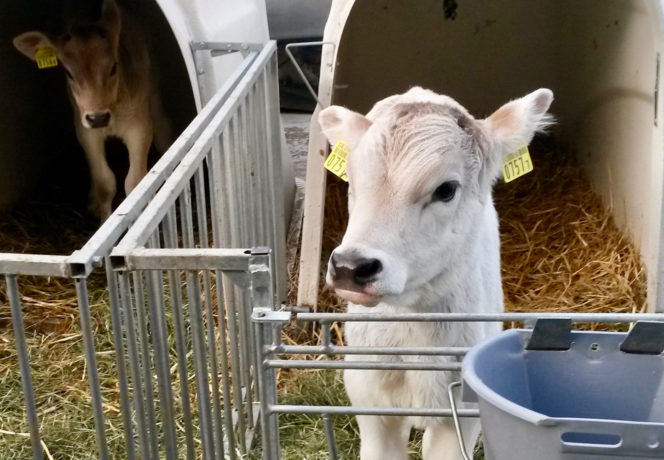
Dealing with «surplus» calves in the mountain regions: A study from Grisons, Switzerland
There is a lack of information on how calves are dealt with in mountain regions. Livestock production is important in this agricultural zone and predominantly takes the form of Alpine transhumance. As part of this study, eleven managers of dairy and beef rearing enterprises in the Canton Grisons were interviewed on the issue of calf…

Dairy cows: sanitising of Staphylococcus aureus genotype B-positive herds
Mastitis is the most common disease of cows, and also leads to very high costs in the Swiss dairy industry. A significant percentage of cases can be traced back to the Staphylococcus aureus genotype B (GTB) pathogen. Unlike all other Staphylococcus aureus genotypes, this one is infectious, and thus leads to problems in herds, particularly…

Grain legumes as alternative protein sources for imported protein-rich feed
The low self-sufficiency rate for protein-rich feed and their partly problematic provenance has put the search for alternative protein sources on the political agenda. The main protein source for Swiss livestock is domestic roughage, which accounts for 67 % of the required amount. 25 % of the protein supply is imported. Among the protein-rich, imported…

Genetic parameters of protein efficiency in a Swiss Large White pig population
Pork production contributes to environmental pollution through the emission of nitrogen compounds. In addition, pig fattening in Switzerland requires imports of soybean, since the protein requirement of feed cannot be met by domestic plant-protein sources alone. It is therefore desirable to improve protein efficiency, i.e. to achieve a similar protein uptake in the carcass with…

Good fattening results despite reduced crude protein content in the feed
Feeding strategies to improve the nutritional value of pork and at the same time reduce the environmental burden were examined on three pig farms representing single-feed, two-phase and multi-phase feeding systems. The experimental feed was supplemented with selenium, vitamin E and crushed linseed. Furthermore, the protein content was reduced. Fattening runs with common feed served…

Methane emissions from dairy cows: influence of oilseeds in the feed
The addition of fatty feed components to a dairy cow ration can influence ruminal fermentation, and hence methane formation in the rumen. In a study with 33 Holstein / Red Holstein dairy cows, the influence of two different types of oilseeds (extruded linseed and ground rapeseed) versus a control (rumen-stable fat) was investigated over a…
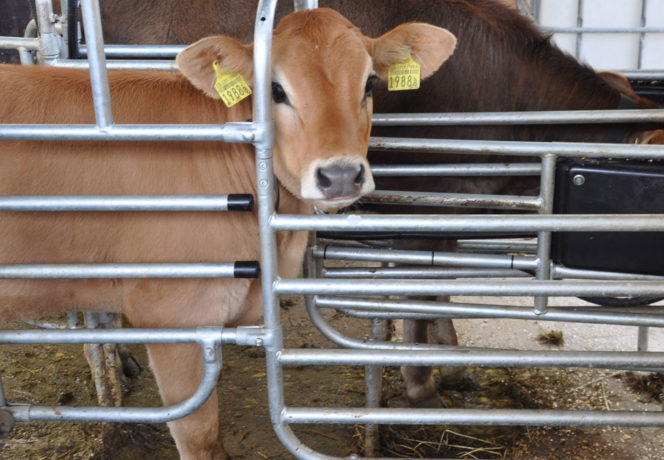
Milk instead of concentrate feed in claf rearing
To promote efficient grassland utilisation and reduce resource use, it is necessary to minimize the amount of concentrates fed to ruminants. Research findings and practical knowledge are available concerning dairy cow management without concentrates, but there is not much literature on rearing calves without concentrates. Textbooks on animal feeding usually recommend calf rearing with concentrates.…
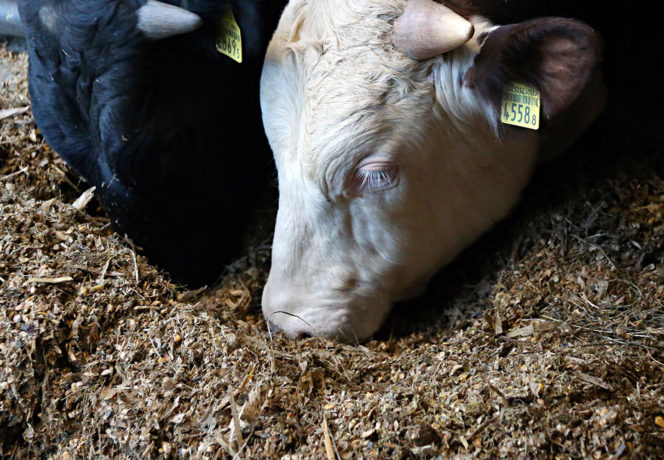
Shredlage maize or standard whole-plant maize in the fattening-bulls ration?
A fattening trial combining two groups of 15 bulls each was carried out at the Agroscope Posieux site in order to study the influence of the shredlage harvest method compared to the conventional method for ensiling whole-plant maize. The animals were crossbreds between a dam from a dairy breed and a sire from a beef…

In vivo digestibility of maize silages harvested with different techniques
A trial was carried out to determine the organic-matter digestibility and nutritional value of whole-plant maize silages (WPMS’s) harvested in different ways. Four methods were compared: standard WPMS from the tower silo removed with a silo unloader, standard WPMS in bales, WPMS shredlage, and cob-enriched WPMS (power maize). According to the chemical analyses, the nutritional…

Percentage of concentrates used on organic dairy farms
The percentage of concentrates used in the ’dairy cattle and rearing’ enterprise or production branch of organic commercial dairies is estimated on the basis of accounting data. On average this comes to 5 %, with 45 % of farms feeding less than 5 % concentrates. There are very few farms that use no concentrates at…
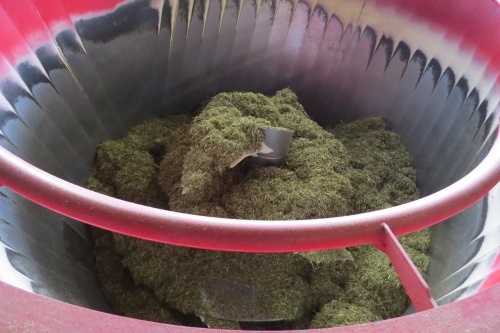
Digestibility of forage in mixed rations
The digestibility of the organic matter (DOM) of a forage, whether estimated in vitro via modelling or determined in vivo via experimentation, is a nutritive value considered in isolation. A ration, however, generally consists of a mixture of different forages and concentrates. This trial – consisting of an in vivo study with wethers – studies…
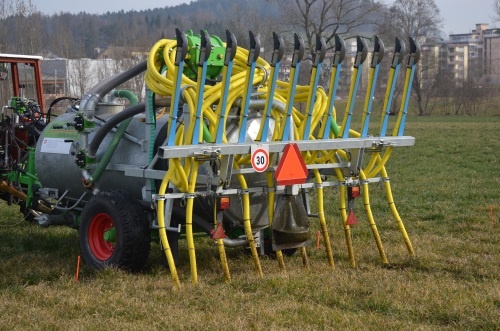
Influence of slurry application technique on yield and nitrogen flows in grassland
Measurement series carried out in Switzerland during different seasons as well as an overview of the literature show that with the use of a trailing hose spreader or trailing shoe spreader, 2–3 kg more nitrogen per hectare ends up in the soil per instance of slurry-spreading than with a broadcast spreader, owing to the escape…

System comparison Hohenrain II: Research combined with knowledge exchange enhances impact on practice
Transferring knowledge between practitioners, researchers, educators and extensionists was a key concern of the ’Optimisation of milk production with fresh grass feeding’ project. The study groups of the participating farms were particularly important. They provided the foundations and data necessary for establishing research questions and worked intensively to implement the new work practices. This triggered…

Methane emission from grazing dairy cows: comparison of methods
Methane emission from free-ranging ruminants can be measured in different ways. In a study with 13 grazing dairy cows, Agroscope compared two methods. The sulfur hexafluoride (SF6) tracer technique is an established method, but its application is challenging and laborious. Before the measurements started, the cows were equipped with a calibrated permeation tube releasing SF6…